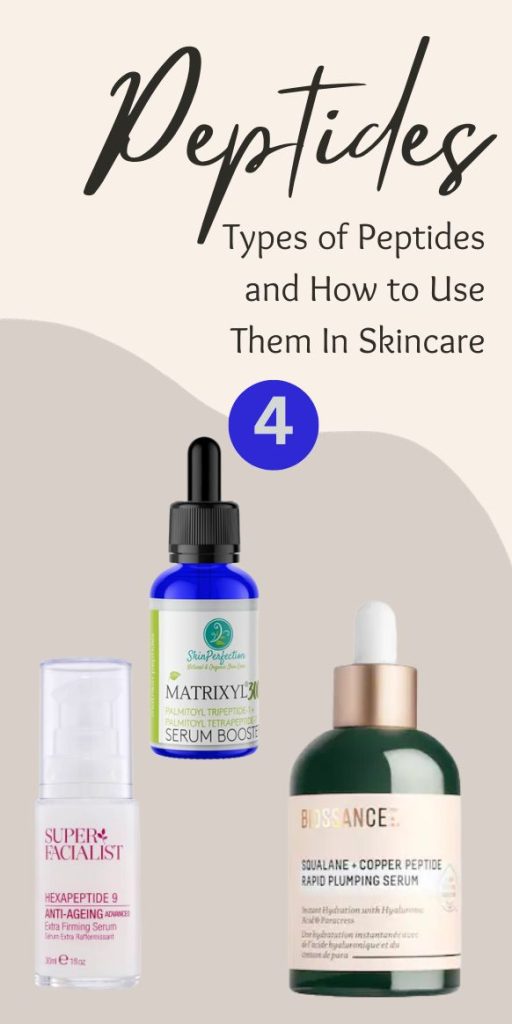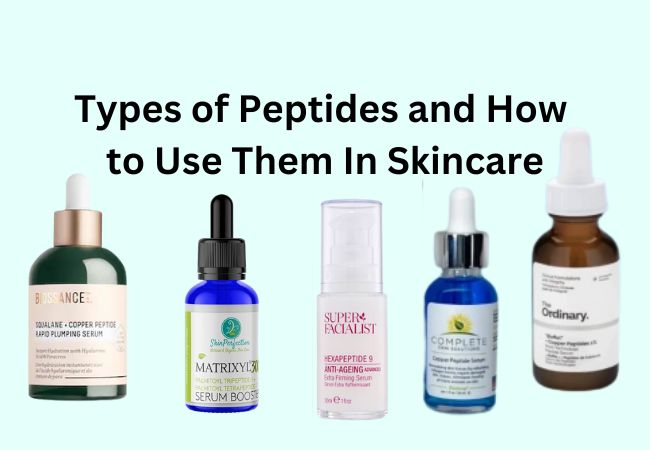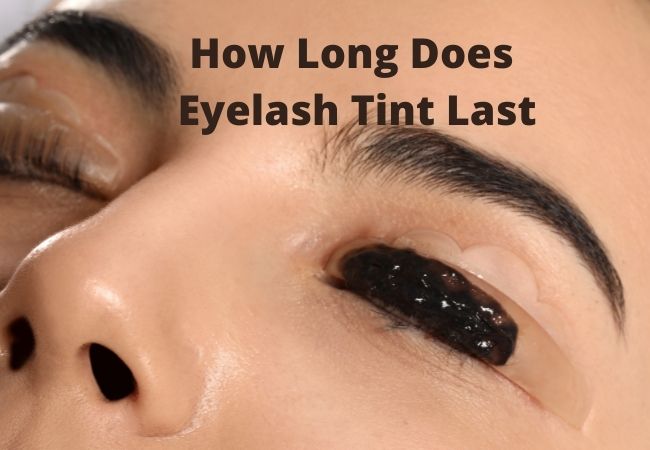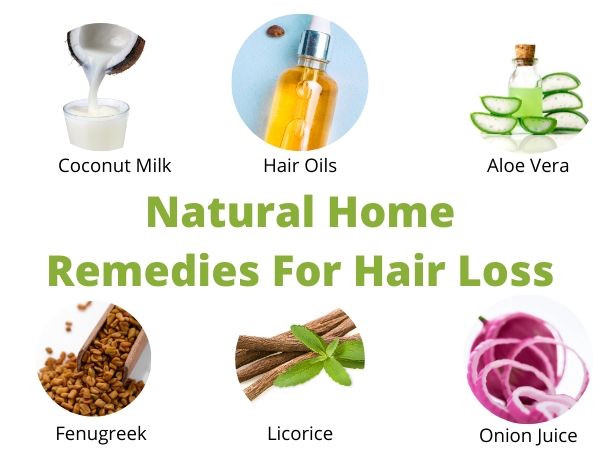The different types of peptides and how to use them in skincare to get the skin you desire. I have seen tremendous improvement in my skin after I started using Copper Peptides.
Types of Peptides and How to Use Them In Skincare
In this post, I cover the different types of peptides and how you can use them to transform your skin.
Skincare enthusiasts are continually seeking effective solutions to enhance their skin health and appearance.
Peptides, often hailed as the building blocks of proteins, have gained significant attention in the skincare industry due to their potential benefits.
Integrating peptides in your skincare routine is easy and they will help you achieve radiant and youthful-looking skin.
Understanding Peptides and Their Benefits
Peptides are short chains of amino acids, the fundamental units that makeup proteins in the skin.
These amino acids play a crucial role in various bodily functions, including the formation and maintenance of skin structure.
In skincare, peptides are recognized for their ability to stimulate collagen production, enhance skin elasticity, and reduce the appearance of fine lines and wrinkles.
Additionally, peptides support overall skin health by promoting hydration and facilitating the healing process.
Different Types of Peptides Used in Skincare
A. Copper Peptides
Copper peptides are probably the most popular type of peptide known for their potential to promote wound healing and collagen synthesis.
They are often used to improve skin elasticity and firmness, making them a valuable ingredient in anti-aging skincare products.
B. Palmitoyl Peptides
Palmitoyl peptides are a class of peptides commonly found in anti-aging formulations.
They help in stimulating collagen and elastin production, thereby reducing the signs of aging, including fine lines and wrinkles.
C. Hexapeptides
Hexapeptides are smaller peptides that work by relaxing facial muscles. They are often included in skincare products targeting expression lines, such as forehead wrinkles and crow’s feet.
D. Tetrapeptides
Tetrapeptides are known for their ability to improve skin hydration and texture. They can also assist in minimizing the appearance of wrinkles and fine lines.
E. Oligopeptides
Oligopeptides are short chains of amino acids that can penetrate the skin and deliver targeted benefits.
Oligopeptides play a significant role in various skincare formulations aimed at rejuvenating the skin and addressing specific concerns.
How to Choose the Right Peptides for Your Skin
Selecting the appropriate peptides for your skincare routine depends on your unique skin concerns and goals.
It’s essential to identify what specific issues you want to address, whether it’s anti-aging, hydration, or overall skin rejuvenation.
Consulting a dermatologist or skincare professional can provide valuable insights and help you choose the right peptide-based products that align with your needs.
Understanding the peptide ingredients listed on skincare product labels is crucial. Look for products with peptides that target your specific skin concerns.
For example, if you’re concerned about wrinkles, seek products containing palmitoyl peptides or hexapeptides.
Reading product reviews and conducting thorough research can also guide you in selecting high-quality, effective peptide-based skincare products.
Incorporating Peptides into Your Skincare Routine
To maximize the benefits of peptides, it’s important to follow a proper skincare routine. Here’s how you can effectively incorporate peptides into your daily regimen:
1. Cleansing and Prepping the Skin
Begin your skincare routine by cleansing your face thoroughly to remove any impurities and makeup.
Follow up with a gentle toner to balance the skin’s pH and prepare it to absorb the peptide products effectively.
2. Applying Peptide-Based Serums or Creams
Apply a small amount of peptide-based serum or cream to your face and neck, focusing on areas where you want to see improvements.
Gently massage the product into your skin using upward motions until fully absorbed.
3. Combining Peptides with Other Skincare Ingredients
Peptides can complement other skincare ingredients such as hyaluronic acid, antioxidants, and retinoids.
Layer these products appropriately, allowing each product to be absorbed before applying the next.
Frequency and Timing of Peptide Application
The frequency of peptide application can vary based on the product and its concentration.
However, most peptide-based products are suitable for daily use, typically applied in the morning and evening as part of your skincare routine.
Always follow the instructions provided by the manufacturer for the best results.
Tips for Maximizing the Effectiveness of Peptides
Proper Storage and Handling of Peptide-Based Products
Peptide-based skincare products should be stored in a cool, dry place away from direct sunlight to maintain their effectiveness.
Ensure that you seal the product tightly after each use to prevent exposure to air, which can degrade the peptides.
Complementing with a Balanced Diet and Hydration
Incorporate a balanced diet rich in proteins and essential nutrients to support the production of peptides within your body.
Additionally, staying adequately hydrated helps maintain skin health and allows peptides to function optimally.
Monitoring and Adjusting Your Skincare Routine Based on Results
Regularly assess your skin’s response to peptide-based products and adjust your skincare routine as needed.
If you experience any adverse reactions, discontinue use and consult a dermatologist for further guidance.
Potential Side Effects and Precautions
While peptides are generally considered safe for most skin types, some individuals may experience mild irritation or redness, especially if they have sensitive skin.
Some people also experience some negative side effects because of combining peptides with other actives.
It’s advisable to conduct a patch test before using any new skincare product to ensure compatibility and minimize the risk of adverse reactions.
Final Thoughts
Incorporating peptides into your skincare routine can offer numerous benefits, ranging from anti-aging effects to enhanced skin hydration and rejuvenation.
These success stories serve as inspiration for others considering peptides as part of their skincare regimen.
Always remember to consult a skin care professional for personalized advice and recommendations tailored to your skin’s unique needs.
I have seen visible improvement in the feel and appearance of my skin which I attribute partially to the addition of peptides into my skincare routine.
I hope this post on types of peptides and how to use them in skincare was helpful. Follow me on Beautythings Pinterest for more awesome skincare and makeup posts.








